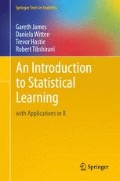Abstract
In the regression setting, the standard linear model
is commonly used to describe the relationship between a response Y and a set of variables \(X_{1},X_{2},\ldots,X_{p}\). We have seen in Chapter 3 that one typically fits this model using least squares.
Access this chapter
Tax calculation will be finalised at checkout
Purchases are for personal use only
Notes
- 1.
Though forward stepwise selection considers \(p(p + 1)/2 + 1\) models, it performs a guided search over model space, and so the effective model space considered contains substantially more than \(p(p + 1)/2 + 1\) models.
- 2.
Like forward stepwise selection, backward stepwise selection performs a guided search over model space, and so effectively considers substantially more than \(1 + p(p + 1)/2\) models.
- 3.
Mallow’s C p is sometimes defined as \(C_{p}^{\prime} = \mbox{ RSS}{/\hat{\sigma }}^{2} + 2d - n\). This is equivalent to the definition given above in the sense that \(C_{p} {=\hat{\sigma } }^{2}(C_{p}^{\prime} + n)\), and so the model with smallest C p also has smallest C p ′.
- 4.
More details can be found in Section 3.5 of Elements of Statistical Learning by Hastie, Tibshirani, and Friedman.
- 5.
In order for glmnet() to yield the exact least squares coefficients when λ = 0, we use the argument exact=T when calling the predict() function. Otherwise, the predict() function will interpolate over the grid of λ values used in fitting the glmnet() model, yielding approximate results. When we use exact=T, there remains a slight discrepancy in the third decimal place between the output of glmnet() when λ = 0 and the output of lm(); this is due to numerical approximation on the part of glmnet().
Author information
Authors and Affiliations
Rights and permissions
Copyright information
© 2013 Springer Science+Business Media New York
About this chapter
Cite this chapter
James, G., Witten, D., Hastie, T., Tibshirani, R. (2013). Linear Model Selection and Regularization. In: An Introduction to Statistical Learning. Springer Texts in Statistics, vol 103. Springer, New York, NY. https://doi.org/10.1007/978-1-4614-7138-7_6
Download citation
DOI: https://doi.org/10.1007/978-1-4614-7138-7_6
Published:
Publisher Name: Springer, New York, NY
Print ISBN: 978-1-4614-7137-0
Online ISBN: 978-1-4614-7138-7
eBook Packages: Mathematics and StatisticsMathematics and Statistics (R0)

